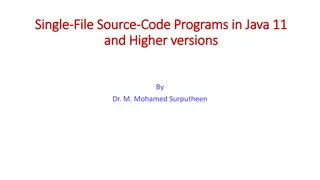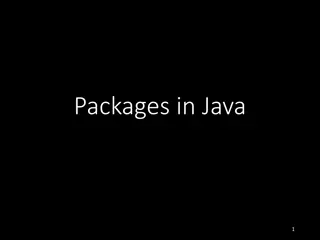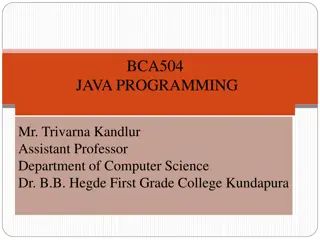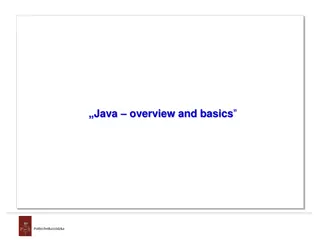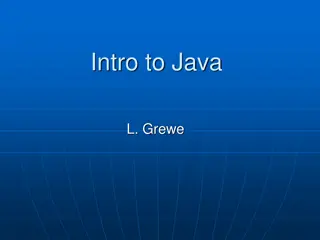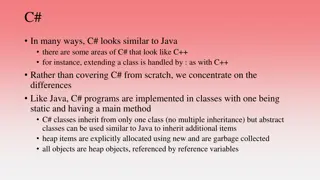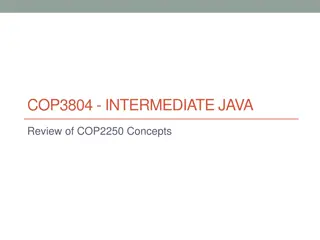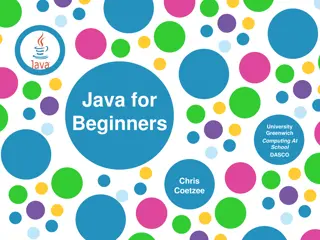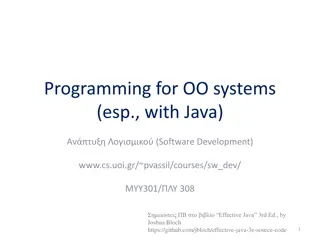Java Control Structures Part 1 - Basics and Examples
Java control structures are essential for creating programs with branching statements and looping constructs. Explore if statements, if-else statements, and their practical application in Java programming. Dive into examples illustrating the use of control structures to enhance program flow and logic.
Download Presentation

Please find below an Image/Link to download the presentation.
The content on the website is provided AS IS for your information and personal use only. It may not be sold, licensed, or shared on other websites without obtaining consent from the author.If you encounter any issues during the download, it is possible that the publisher has removed the file from their server.
You are allowed to download the files provided on this website for personal or commercial use, subject to the condition that they are used lawfully. All files are the property of their respective owners.
The content on the website is provided AS IS for your information and personal use only. It may not be sold, licensed, or shared on other websites without obtaining consent from the author.
E N D
Presentation Transcript
Chapter 5 Java Control Structures Part 1
In This Chapter you will be able to: Know Java Programming Control Structures Understand the Difference between a looping constructs and branching Statements Realize the importance of Control Structures in creating programs Create program using Java Control Structures
Java if Statements When you are writing computer programs, you are constantly hitting forks in roads. Did the user correctly type the password? If yes, let the user work; if no, kick the bum out. So, the Java programming language needs a way of making a program branch in one of two directions. Fortunately, the language has a way: It is called an if statement.
In its most basic form, an if statement lets you execute a single statement or a block of statements only if a Boolean expression evaluates to true. The basic form of the if statement looks like this: if (boolean-expression)statement
Heres an example of a typical if statement: double commissionRate = 0.0; if (salesTotal > 10000.0) commissionRate = 0.05;
double commissionRate = 0.0 Sales Total > 10000 commissionRate =0.05 Fig. 5.1: Flow Sequence of If Statement
Heres an example that uses a block rather than a single statement: double commissionRate = 0.0; if (salesTotal > 10000.0){ commissionRate = 0.05; commission = salesTotal * commissionRate; }
If - else statements An if-else statement adds an additional element to a basic if statement: a statement or block that is executed if the boolean expression is not true. Its basic format is if (boolean-expression) statement else statement
Here is an example: double commissionRate; if (salesTotal <= 10000.0) commissionRate = 0.02; else commissionRate = 0.05;
double commissionRate = 0.0 Sales Total > 10000 commissionRate = 0.02 commissionRate =0.05 Fig. 5.2: Flow Sequence of If else Statement
Nested if statements The general form of a nested if statement if (expression-1) if (expression-2) statement-1 else statement-2 else if (expression-3) statement-3 else statement-4
Table 5.1: Sales and Classes Table Class 1 Class 2 Sales 2% 2.5% 0 to 9,999 4% 5% 10,000 and over Write a Java program that will determine the commission rate of a sales agent base on the table given above. Check the handouts for one the correct solutions
if (salesClass == 1) if (salesTotal < 10000.0) else else if (salesTotal < 10000.0) commissionRate = 0.025; else commissionRate = 0.05; commissionRate = 0.02; commissionRate = 0.04;
Fig. 5.3: Flow Sequence of Nested If Statement double commissionRate = 0.0 Yes Sales Total <10000 SalesClass = 1 Yes No No commissionRate =0.02 commissionRate =0.04 Yes Sales Total <10000 commissionRate =0.025 No commissionRate =0.005
else-if statements A common pattern for nested if statements is to have a series of if-else statements with another if-else statement in each else part: if (expression-1) statement-1 else if (expression-2) statement-2 else if (expression-3) statement-3
else-if statements These statements are sometimes called else-if statements, although that term is unofficial. Officially, all that is going on is that the statement in the else part happens to be another if statement so this statement is just a type of a nested if statement.
It is an especially useful form of nesting, however. Suppose that you want to assign four commission rates based on the sales total, according to this table: Table 5.2: Sales and Commission Table Commission Sales 5% Over $10,000 3.5% $5,000 to $9,999 2% $1,000 to $4,999 0% Under $1,000
You can easily implement a series of else-if statements: if (salesTotal >= 10000.0) commissionRate = 0.05; else if (salesTotal >= 5000.0) commissionRate = 0.035; else if (salesTotal >= 1000.0) commissionRate = 0.02;
Fig. 5.4: Flow Sequence for Else - If Statement double commissionRate = 0.0 No Yes salesTotal >= 10000 commissionRate =0.00 No Yes salesTotal >= 5000 commissionRate =0.00 No Yes salesTotal >= 1000 commissionRate =0.00 No commissionRate =0.00
Using the ! operator The simplest of the logical operators is Not (!). Technically, it s a unary prefix operator, which means that you use it with one operand, and you code it immediately in front of that operand. The Not operator reverses the value of a boolean expression. Thus, if the expression is true, not changes it to false. If the expression is false, not changes it to true.
Example double commissionRate = 0.0; if (!(salesTotal > 10000.0) ) commissionRate = 0.05;
The & and && operators The & and && operators combine two boolean expressions and return true only if both expressions are true. This type of operation is called an AND operation, because the first expression and the second expression must be true for the AND operator to return true.
Suppose that the sales commission rate should be 2.5% if the sales class is 1 and the sales total is $10,000 or more. You could perform this test with two separate if statements (as I did earlier in this chapter), or you could combine the tests into one if statement: if ((salesClass == 1) & (salesTotal >= 10000.0)) commissionRate = 0.025;
In previous slide, the expressions (salesClass == 1) and (salesTotal >= 10000.0) are evaluated separately. Then the & operator compares the results. If they are both true, the & operator returns true. If one is false or both are false, the & operator returns false.
Note: The use of parenthesis in enclosing both conditional statements is important for the & operator be able to determine where the first conditional expression ends and the second conditional expression begins.
The | and || operators The | and || operators are called OR operators because they return true if the first expression is true or if the second expression is true. They also return true if both expressions are true.
Example if ((salesTotal < 1000.0) | (salesClass == 3)) commissionRate = 0.0;
To evaluate the expression for this if statement, Java first evaluates the expressions on either side of the | operator. Then, if at least one of these expressions is true, the whole expression is true. Otherwise the expression is false.
The ^ operator The ^ operator performs what in the world of logic is known as an Exclusive OR, commonly abbreviated as XOR. It returns true if one and only one of the two subexpressions is true. If both expressions are true, or if both expressions are false, the ^ operator returns false
Example if ((switch1==1)^(switch2==-1)) System.out.println ("OK, the switches are different."); else System.out.println ("Trouble! The switches are the same");
The Conditional Operator Java has a special operator called the conditional operator that is designed to eliminate the need for if statements in certain situations. It is a ternary operator, which means that it works with three operands. The general form for using the conditional operator is this: boolean-expression ? expression-1 : expression-2
The boolean expression is evaluated first. If it evaluates to true, expression-1 is evaluated, and the result of this expression becomes the result of the whole expression. If the expression is false, expression-2 is evaluated, and its results are used instead.
Example int tier = salesTotal > 10000.0 ? 1 : 0; or int tier = (salesTotal > 10000.0) ? 1 : 0;
Comparing Strings Comparing strings in Java takes a little extra care, because the == operator really doesn t work the way it should. Suppose that you want to know whether a string variable named answer contains the value "Yes". You may be tempted to code an if statement like this: if (answer == "Yes") System.out.println ("The answer is Yes.");
Unfortunately, that is not correct. The problem is that in Java, strings are reference types, not primitive types; when you use the == operator with reference types, Java compares the references to the objects, not the objects themselves. As a result, the expression answer == "Yes" doesn t test whether the value of the string referenced by the answer variable is "Yes". Instead, it tests whether the answer string and the literal string "Yes" point to the same string object in memory.
Example if (answer.equals("Yes")) System.out.println ("The answer is Yes.");
Switch Statement A common practice in programming in any language is to test a variable against some value, and if it doesn t match that value, to test it again against a different value, and if it doesn t match that one to make yet another test, and so on. Using only if statements, this can become unwieldy, depending on how it is formatted and how many different options you have to test.
Example switch (test) { case value One: resultOne; break; case valueTwo: resultTwo; break; case valueThree: resultThree; break; ... default: defaultresult; }
Excellent! We have completed part 1 of this chapter









